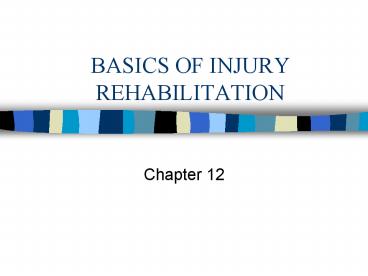BASICS OF INJURY REHABILITATION PowerPoint PPT Presentation
1 / 12
Title: BASICS OF INJURY REHABILITATION
1
BASICS OF INJURY REHABILITATION
- Chapter 12
2
Introduction
- Rehabilitation of athletic injuries through
programs utilizing progressive therapeutic
exercises, is a major responsibility of the
athletic trainer. - Today athletic trainers must perform
rehabilitation programs on athletes in the
traditional setting, as well as in the clinical
setting on the non-traditional athlete.
3
Therapeutic Exercise Versus Conditioning Exercise
Programs
- Effects of General Inactivity Immobilization on
the Body - Effects on Muscle
- Effects on Joints
- Effects on Cardiorespiratory System
4
Major Components of a Rehabilitation Program
- Minimizing Swelling
- Controlling Pain
- Restoring Range of Motion
- Physiological versus Accessory Movements
- Restoring Muscular Strength, Endurance and Power
5
Types of Exercises
- Isometric Exercises
- Isotonic Exercises
- Progressive Resistive Exercises
- Concentric and Eccentric Exercises
- Isokinetic Exercises
- Testing Strength, Endurance Power
- Reestablishing Proprioception
6
Rehab of a ligament
- assess degree of injury
- immobilize joint (all ankles, shoulders,
wrists, etc.) For first 48 hours - place injured ligament in shortened position in
order to heal as close to pre-stretched length
as possible (mid-range of joint) - controlled range of motion for healing to occur
along the lines of stress (pain free range of
motion exercises) - controlled strengthening exercises (need to
move out of mid range to stress inert and
contractile t tissue)
7
Rehab of Strains (must be pain free)
- PIER
- assess degree of injury
- gradual increase in stretching of injured muscle
(must be pain free) - gradual increase in strengthening of injured
muscle (isometric, isokinetic, isotonic) - gradual return to activity - sport specific
exercises - proprioceptive exercise
- maintain CV fitness
- maintain joint above and below, opposite limb and
rest of body
8
Treatment for Tendonitis
- Rest, PIER
- find cause and make appropriate adjustments
- recognise signs and symptoms early to prevent
condition from worsening - gradual stretch and strength
- must do eccentric loading for complete recovery
- sport specific activity and gradual return to
sport
9
Treatment for Contusions
- PIER
- restricted movement
- treat as strain after acute phase
10
Developing a Rehab Plan
- Exercise Phases
- Controlling Mobility during Rehabilitation
- Adhering to a Rehabilitation Program
- Criteria for Full Return to Activity
11
Additional Approaches
- Open versus Closed Kinetic Chain Exercise
- Aquatic Exercise
- PNF Techniques and Patterns
- Joint Mobilization and Traction
- Mobilization Techniques
12
Summary
- Athletic Trainers use of Rehabilitation
- Effects of Inactivity Immobilization
- Major Components of a Rehab Program
- Developing a Rehabilitation Plan
- Additional/Unusual Approaches to Rehabilitation
and Uses of Therapeutic Exercises

